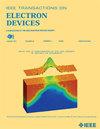HfO₂–ZrO₂ Superlattice HZO Ultrathin Poly-Si Channel (3.5 nm) Junctionless FeTFTs Exhibiting Superior Endurance and Robust Retention
IF 2.9
2区 工程技术
Q2 ENGINEERING, ELECTRICAL & ELECTRONIC
引用次数: 0
Abstract
In this study, HfO2–ZrO2 superlattice (SL) HfZrO2 (HZO) 3.5-nm ultrathin poly-Si channel (UTPC) junctionless (JL) ferroelectric thin-film transistors (FeTFTs) with the two types of HfO2/ZrO2 nanolamination (NL) thicknesses (0.5 and 1.0 nm) and a 1.0-nm ZrO2 seed layer were experimentally investigated and discussed their ferroelectricity and reliability for the first time. Compared with the conventional HZO UTPC JL FeTFTs, the SL HZO UTPC JL FeTFTs with a HfO2 and ZrO2 NL thickness of 1 nm achieved a relatively large pristine/residual pulsed memory window (MW) up to 1.09/1.06 V under a very low pulse heightHfO₂-ZrO₂ 超晶格 HZO 超薄聚硅氧烷通道(3.5 nm)无结 FeTFT 显示出卓越的耐久性和稳定的保持力
本研究对HfO2 - ZrO2超晶格(SL) HfZrO2 (HZO) 3.5 nm超薄多晶硅通道(UTPC)无结(JL)铁电薄膜晶体管(FeTFTs)进行了实验研究,并首次讨论了两种HfO2/ZrO2纳米层厚度(0.5和1.0 nm)和1.0 nm ZrO2种子层的铁电性和可靠性。与传统的HZO UTPC JL场效应管相比,HfO2和ZrO2 NL厚度为1 nm的SL HZO UTPC JL场效应管在极低的脉冲高度$\times $脉冲宽度降至$0.8~\mu $ Vs下获得了相对较大的原始/残余脉冲记忆窗口(MW),达到1.09/1.06 V,几乎为零的MW降解率($\Delta $ MW/MW $_{,\text {pristine}}$)降至2.8% after the endurance test up to $10^{{7}}$ cycles. Furthermore, the SL HZO UTPC JL FeTFTs with an NL thickness of 1 nm exhibited a robust 10/298/423 K retention characteristic for 25 h with a sufficiently large pulsed MW of 1.30/1.38/0.65 V, and the synaptic behavior with a maximum channel conductance over 1400 nS. According to pulsed characteristic and reliability viewpoints, the HfO2–ZrO2 SL HZO UTPC JL FeTFTs are greatly promising candidates for 3-D nand nonvolatile memories (NVMs) and neuromorphic systems.
本文章由计算机程序翻译,如有差异,请以英文原文为准。
求助全文
约1分钟内获得全文
求助全文
来源期刊

IEEE Transactions on Electron Devices
工程技术-工程:电子与电气
CiteScore
5.80
自引率
16.10%
发文量
937
审稿时长
3.8 months
期刊介绍:
IEEE Transactions on Electron Devices publishes original and significant contributions relating to the theory, modeling, design, performance and reliability of electron and ion integrated circuit devices and interconnects, involving insulators, metals, organic materials, micro-plasmas, semiconductors, quantum-effect structures, vacuum devices, and emerging materials with applications in bioelectronics, biomedical electronics, computation, communications, displays, microelectromechanics, imaging, micro-actuators, nanoelectronics, optoelectronics, photovoltaics, power ICs and micro-sensors. Tutorial and review papers on these subjects are also published and occasional special issues appear to present a collection of papers which treat particular areas in more depth and breadth.
 求助内容:
求助内容: 应助结果提醒方式:
应助结果提醒方式:


